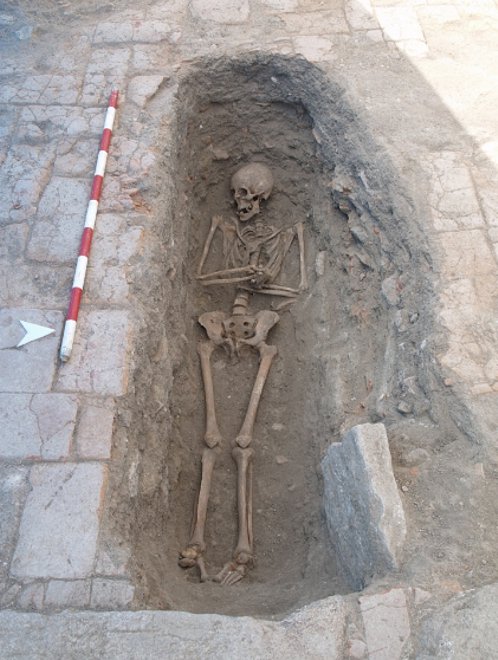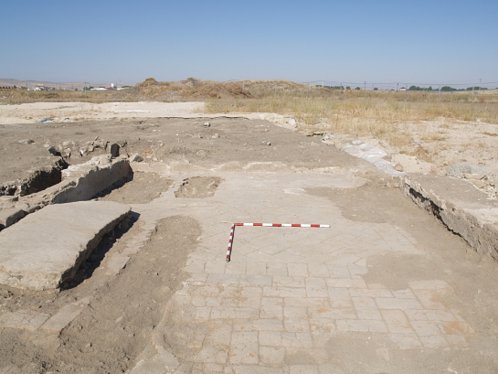During this season of excavation at the site of El Vergel, plus the aforementioned burials, we have been able to confirm the existence of at least one room that also has a mosaic floor. This room, located north of the East-West corridor, appears rectangular but it isn’t fully defined so far. The mosaic decorative pattern is geometric, polychromatic, with square and octagonal coffered and bordered with swastikas. Although having some alterations, in general it can be said that its condition is good. As in previous campaigns, the procedure for cleaning is the removal of lime concretion covering it with scalpels and spatulas. Once this work is complete, we will proceed to consolidate it in an attempt to prevent fracture zones from expanding or degrading.
 Polychrome mosaic floor decorated with geometric motifs. We can see that the conservation of the pavement is good, despite the existence of some "gaps".
Polychrome mosaic floor decorated with geometric motifs. We can see that the conservation of the pavement is good, despite the existence of some "gaps".
Meanwhile, the areas occupied by burials are being cleared. The work has been done in an area related to an ancient hermitage up until recently. In this space, paved with clay tiles arranged in spikes, we have been able to document the existence of modern day burials placed in simple pits; buried in the supine position, their conservation is generally good. Note that the upper extremities are bent and hands resting on the abdomen or pelvic area.
 This photo is of one of the burials. This is an adult in the supine position. Facing West-East (head-feet), upper limbs are bent and hands together, resting on the abdominal area.
This photo is of one of the burials. This is an adult in the supine position. Facing West-East (head-feet), upper limbs are bent and hands together, resting on the abdominal area. View of the possible chapel. There is clay tile pavement, also practiced burial pits can be identified.
View of the possible chapel. There is clay tile pavement, also practiced burial pits can be identified.Translated by Lara M. Moreda
Edited by Andrew B. Greeves
Edited by Andrew B. Greeves




 This photo is of of a stone object (called Cupa) that has a deposit to introduce the ash, and also has a libations channel.
This photo is of of a stone object (called Cupa) that has a deposit to introduce the ash, and also has a libations channel. A view of the area in which, we will excavate, during this campaign. The open area already shows the existence of a large number of graves.
A view of the area in which, we will excavate, during this campaign. The open area already shows the existence of a large number of graves. A photo of the previous picture that shows one burial with a stone coffin and another one on a simple pit with stone reinforcements in the foot-well.
A photo of the previous picture that shows one burial with a stone coffin and another one on a simple pit with stone reinforcements in the foot-well. Sarcophagus image.
Sarcophagus image.